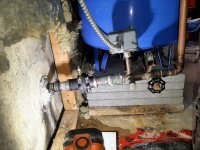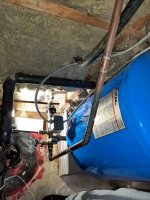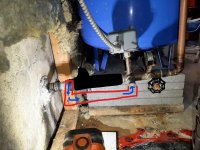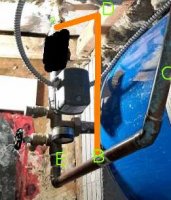JedTheHumanoid
New Member
Hi,
I am replacing my iron treatment system, which relies on a micronizer to inject air to oxidize the iron. The micronizer is located between the well pump and pressure tank (the entire black unit in the pic). I need to remove this micronizer and replace it with just a straight pipe for my new system (it doesn't need it, and the micronizer reduces GPM).
What is the best way to get this out, and replace it? Would PVC or nylon pipe/fittings work fine, and be able to screw directly onto the existing 1" copper male threads? Any suggestions of the best approach to get this thing out? Thanks

EDIT - added a few more pics
I am replacing my iron treatment system, which relies on a micronizer to inject air to oxidize the iron. The micronizer is located between the well pump and pressure tank (the entire black unit in the pic). I need to remove this micronizer and replace it with just a straight pipe for my new system (it doesn't need it, and the micronizer reduces GPM).
What is the best way to get this out, and replace it? Would PVC or nylon pipe/fittings work fine, and be able to screw directly onto the existing 1" copper male threads? Any suggestions of the best approach to get this thing out? Thanks
EDIT - added a few more pics
Attachments
Last edited:





